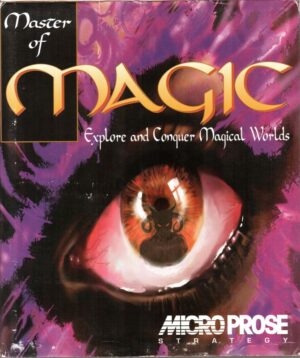Retro Replay Review
Gameplay
Big Blue Disk #30 packages two distinct arcade-style experiences—Submarine and Meteors—under one subscription offering. Submarine tasks you with navigating the depths, tracking enemy vessels on a rudimentary sonar grid and launching torpedoes at moving targets. Its simple, menu‐driven interface belies a surprising level of strategic depth as you balance depth control, enemy evasion, and ammunition management.
(HEY YOU!! We hope you enjoy! We try not to run ads. So basically, this is a very expensive hobby running this site. Please consider joining us for updates, forums, and more. Network w/ us to make some cash or friends while retro gaming, and you can win some free retro games for posting. Okay, carry on 👍)
Meteors delivers a classic shoot-‘em-up challenge reminiscent of arcade mainstays. You pilot a lone ship amidst a field of drifting space rocks, firing your thrusters and lasers to break large meteors into smaller fragments while avoiding collision. Despite its straightforward controls, the game’s increasing speed and density of asteroids keep tension high and encourage repeated plays to beat your high score.
Beyond the games, the disk’s text-based launcher offers quick access to utilities and applications that extend your interactive experience. PC Strokes, a drawing program, invites users to create freehand artwork with mouse or keyboard, while the included fractal-drawing software lets you generate and explore intricate Mandelbrot and Julia sets. Transitioning from gaming to creative outlets feels seamless, thanks to the consistent menu navigation.
Replay value is bolstered by both the competitive nature of Meteors and the layered strategy found in Submarine’s sonar puzzles. Add the occasional diversion of experimenting with drawing tools or browsing clip art galleries, and you’ll find yourself returning to Big Blue Disk #30 not just for high scores, but for creative exploration as well.
Graphics
Given the era’s hardware constraints, Big Blue Disk #30 delivers competent visuals that blend text-mode menus with CGA-style color in games and applications. Submarine’s sonar grid is rendered in a clean, monochrome matrix with clear character-based indicators for depth and target tracking. This simplicity enhances readability, even if it sacrifices photorealism.
Meteors takes a different tack, using vector-like graphics to depict your ship and floating rocks. The sharp, bright shapes stand out against the black background, making it easy to track fast-moving elements. While pixelated by modern standards, the game’s visual clarity and smooth motion capture the feel of arcade cabinet classics.
The drawing utilities shine when it comes to creative expression. PC Strokes offers a palette of shades and brush shapes, allowing you to sketch freestyle or build diagrams with surprising precision. The fractal-drawing software generates colorful, zoomable fractal images that look impressive on a standard CGA setup, turning simple equations into vibrant patterns.
Complementing these programs is a modest collection of clip art and graphical articles, which showcase the era’s amateur and semi-professional artwork. Whether you’re pulling illustrations into a document or simply browsing for inspiration, the assortment feels generous for a subscription disk of this period.
Story
Unlike narrative-driven titles, Submarine and Meteors focus on pure gameplay rather than elaborate plots. Submarine hints at Cold War engagements, tasking you with covert operations beneath the waves, while Meteors drops you into an endless cosmic field with only your reflexes as a guide. Their “stories” emerge from your own high-score pursuits and mission attempts rather than scripted cutscenes or dialogue.
Where storytelling does appear is in the editorial content scattered throughout the disk. A highlight is the in-depth review of the Adventure Game Toolkit, which explores how hobbyists and budding designers can craft their own text adventures. This meta-narrative about game creation adds a layer of industry insight that complements the playable titles.
Articles on fractal mathematics and PC-based art serve as mini-features, offering background on the science and technique behind some of the included utilities. These write-ups turn what could be a simple games disk into a magazine-style compilation, weaving together play, creation, and education.
In the absence of a traditional storyline, the overall “narrative” of Big Blue Disk #30 becomes one of exploration—exploring digital seas, uncharted asteroid fields, and your own creative potential—guided by a blend of gaming and informative content.
Overall Experience
Big Blue Disk #30 represents the mid-’80s PC subscription ethos at its best: a curated sampler of games, productivity tools, and editorial features delivered on floppy disk. For the price of a single magazine, subscribers receive hours of gameplay, a pair of creative applications, and insightful articles that broaden their understanding of early game design.
Submarine and Meteors satisfy different itch-scratching desires—strategy and reflex—but share a pick-up-and-play immediacy that makes them accessible to both novices and seasoned players. Meanwhile, the drawing and fractal utilities extend the disk’s appeal beyond gaming, encouraging users to tinker and create.
Navigation through the text-based menu is swift and intuitive, though some may find the lack of graphical flair dated by today’s standards. Yet the utilitarian interface ensures that even on lower-end hardware, all programs load quickly without fuss.
Overall, Big Blue Disk #30 offers a well-rounded package for collectors, retro gamers, and PC enthusiasts interested in a snapshot of period software. It’s less about blockbuster entertainment and more about variety—an affordable gateway into both arcade thrills and homegrown creativity.
 Retro Replay Retro Replay gaming reviews, news, emulation, geek stuff and more!
Retro Replay Retro Replay gaming reviews, news, emulation, geek stuff and more!




Reviews
There are no reviews yet.